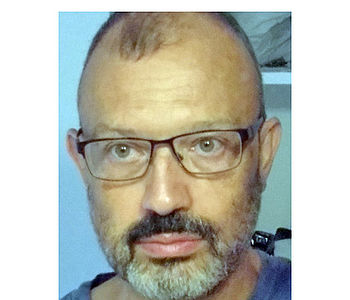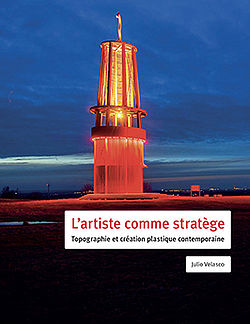Dr. Julio Velasco | Assoziierter Forscher

Position
:
Chercheur Associé
|
Fachbereich
:
Ästhetik
,
Kulturwissenschaften
,
Kunstgeschichte
,
Soziologie der Kunst
|
Biographie
- Coorganisation of the "Art and Research" group at the Marc Bloch Center, with Etienne Jollet, Professor of Art History at the University of Paris 1, and Marion Picker, Associate Professor of Germanic Studies at the University of Poitiers (the group was created by J. Velasco, Etienne Jollet, and Boris Grésillon, Professor of Geography at the University of Aix-Marseille).
- Research Grant from the Centre Marc Bloch de Berlin, 2018 and 2019.
- Research Grant from the DAAD, 2017.
- PhD in Art and Arts Sciences, Université de Paris 1, Panthéon-Sorbonne, 2017.
- “Artist Researcher” at Art and Sciences laboratory, University of Paris I, Panthéon-Sorbonne, 2011-2013.
- Member of the Leonardo Electronic Directory (LED).
Stipendium
DAAD scholarship in the programme Research Grants
Centre Marc Bloch de Berlin
Titel der Dissertation
The artist as a strategist. Topography of contemporay art in Paris at the beginning of the 21st century
Zusammenfassung der Dissertation
This work is about the question of art territories, but not for their repercussions on their neighbourhood, but for their contribution to the plastic creation itself. In the first part, the terms of the research are defined: the word "strategy"; the "art districts" according to their use; the "people of art". The second part presents, in addition to a historical synthesis, six territories of contemporary art: Faubourg Saint-Denis (Paris), which is the backbone of this work, Macarena (Bogota), San Telmo (Buenos Aires), Belleville (Paris), the Red Hook (New York) and the city of Berlin. The third part analyses the individual work of seven contemporary art personalities who lived in Faubourg Saint-Denis since 2000: Nathalie Heinich, Nicolas Bourriaud, Jean-Philippe Antoine, Thomas Hirschhorn, Esther Shalev-Gerz, Pierre Huyghe and Olga Kisseleva. The last part links this research with the work of its author. The conclusion highlights a series of hypotheses emerging from this study: places of art as an instrument of identification of the different groups working in art; the notion of "debate" as a form of strategy, with an internal level (who participates and in what capacity) and a global level (the role of art in society); artists considered not as a socio-professional category, but as "products" of every social group; art as a form of participation in a common territory more than as a self space.
Institution der Dissertation
Projekte
- The memory of plants and "La Expedición botánica" in Colombia (1783-1816).
http://julio-velasco.eu/001InProgExpB.html
- Berlin, a city that creates artists. Practical function and symbolic function of a territory in contemporary art creation. http://julio-velasco.eu/006ReseBerlin.html
- Beauty and Technology.
http://julio-velasco.eu/006ReseBeauty.html
- Nationalisms in Latin American contemporary art.
http://julio-velasco.eu/006ReseLatinAmer.html
- Neukölln : "Art Quarter / Immigrant Quarter".
http://julio-velasco.eu/001InProgNeuk.html
Organisation von Veranstaltungen
- "Auralities: Artistic and Scientific Approaches to Sound Studies", Institut Français de Berlin, Allemagne, Encounter about the "sound" co-organized by J. Velasco, 17 – 18 Janvier 2023.
- "Bio art before Bio art. The living as culture expression". Workshop, 25th and 26th February 2021. Organized by Julio Velasco, Centre Marc Bloch, Berlin ; Klaus Weber, Pr. European University Viadrina, Frankfurt/Oder and Olga Kisseleva, University of Paris 1, Panthéon Sorbonne
- "Nationalismes dans l’art contemporain latino-américain". Journées d'études à Paris, les 23 et 24 septembre 2018, au Deutsches Forum für Kunstgeschiste, co-organisateur avec Laura Karp (chercheur à la Ludwig-Maximilians-Universität München)
- "Configuration du territoire par l'art, approches et méthodes", Workshop in Berlin, Januray 9, 2018 at the Marc Bloch Center of Berlin, and in Paris, May 14, 2018 at the Sorbonne University, co-organiser with Boris Grésillon (Geographer, University Professor, Aix-Marseille University, Associate Researcher at the Marc Bloch Center and Berlin Humboldt University - Chair of Cultural and Social Geography) and Olga Kisseleva (artist-researcher, Senior Lecturer HDR, Université de Paris 1, Panthéon-Sorbonne, Institut ACTE, UMR 8218)
The memory of plants and "La Expedición botánica" in Colombia (1783-1816)
"Kunst und Forschung"
L'Artiste comme stratège. Topographie et création plastique contemporaine
18.März 2021Julio Velasco
Collection: Orientations et méthodes
ISBN: 978-2-7355-0925-6
Issu d’une enquête transdisciplinaire, ce livre s’intéresse aux territoires d’art sous l’angle de leurs rapports avec la production artistique et des transformations qu’ils favorisent à l’in- térieur de celle-ci.
Après une étude historique dédiée à ce type de lieux, six territoires d’art contemporains, dans cinq villes différentes, sont analysés. L’auteur explore ensuite le travail plastique ou théorique de sept personnalités de premier ordre liées à l’art contemporain, ayant habité le quartier du faubourg Saint-Denis, à Paris, au xxie siècle.
Les comparaisons entre l’ensemble des quar- tiers et le groupe des personnalités de l’art permettent de relever des éléments d’une stra- tégie collective et d’identifier, entre eux, des caractéristiques communes. Le rôle fondamental joué par ces territoires, dans la formation d’une identité artistique comme dans la construction de l’autonomie du champ de l’art contemporain, est ainsi mis en lumière.
Publikationen
- Bio Art, Varieties of the Living in Artworks from the Pre-modern to the Anthropocene, Edité par J. Velasco et K. Weber, Transcript verlag, Bielefeld, October 2024. Open Access.
- The Living in Artworks in Sociocultural and Historical Contexts, in Bio Art, Varieties of the Living in Artworks from the Pre-modern to the Anthropocene, Transcript verlag, Bielefeld, October 2024. J. Velasco et K. Weber. Open Access.
- José Celestino Mutis (1732-1808) ou les Lumières de la périphérie, in Périphéries culturelles et scientifiques, CTHS, Paris, August 2024. Open Access.
- Les voi.es.x de la carte / Tonkörper Berlin, in Cahiers des Umifre, 2023-2024, n° 10, Julio Velasco et Marion Picker. Open Access.
- La memoria de las plantas, in 20 Festival Internacional de la Imagen, Inter/Especies, Manizales, 2022.
- L'artiste comme stratège. Topographie de l ’art contemporain à Paris au début du XXIe siècle.
Currently being published at the CTHS editions.
- "L’image des artistes et des acteurs de l’art contemporain à travers leurs quartiers" in Art collaboratif et territoire,
Editions de la Sorbonne, Paris, 2018.
- "La « Double vie » ou Portrait de l’artiste" in Du travail collectif à l’oeuvre, sous la dir. Olga Kisseleva,
Nouvelles éditions Place, Paris 2017.
- "El ruido del agua" in Ecología desde el arte digital, sous la dir. Luis Germán
Rodríguez Leal et Felipe César Londoño López, Publication Fundación
Telefonica, 2015. http://www.fundacion.telefonica.com.ve/publicaciones
- “Art, société et biodiversité”, in {plastik} n° 4, 2014. http://art-science.univparis1.
fr//document.php?id=931
- "Art et « gentrification »", in Actes du colloque Tours 2012, Paris 2014.
http://cths.fr/ed/edition.php?id=6814
